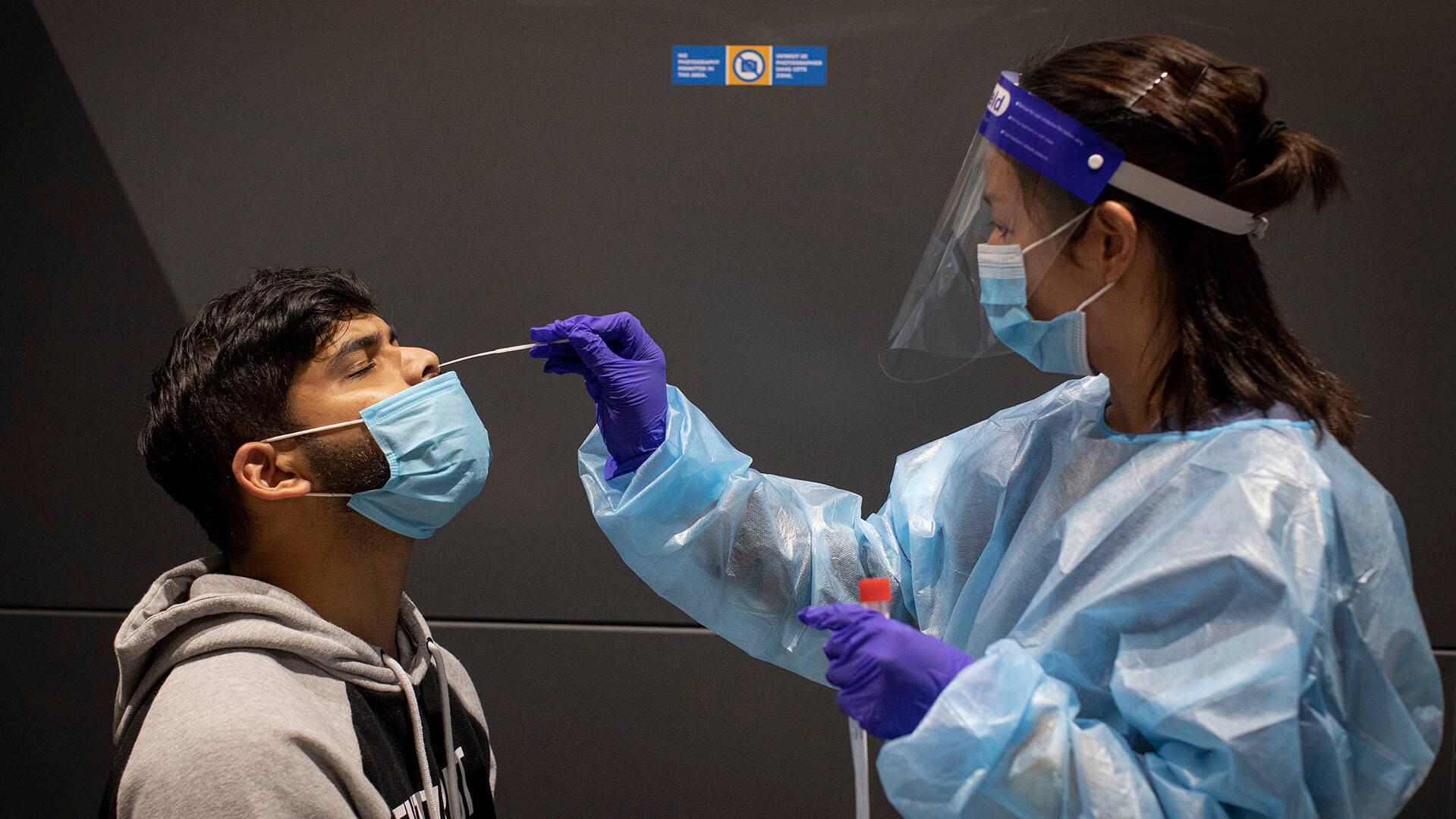
2 Toronto-area hospitals go ‘code orange’ on eve of provincial pause on non-urgent surgeries
Ontario reported at least 11,352 new confirmed cases of COVID-19 and another rise in hospitalizations and ICU admissions on Tuesday, one day before the most significant public health restrictions in nearly a year kick in across the province.
Health Minister Christine Elliott said the latest data shows there were 1,290 people hospitalized with COVID-19. That’s up from 491 at the same time last week, or a 163 per cent increase. There were also 266 patients being treated for COVID-related illnesses in intensive care units, up from 187 one week ago.
As those who’ve tracked the virus in the province may be aware, those numbers are well short of peaks in April 2021, when more than 2,400 were hospitalized and 900 patients were in ICUs.
Very few Ontario adults, relatively speaking, were even partially vaccinated at that point, whereas 77 per cent of the eligible population older than 12 is fully vaccinated now, with significant numbers having receiving a third shot.
While things are better now in terms of population-level protection, health care providers say the cumulative toll of virus waves and the Omicron variant’s increased transmissibility mean that the health-care system would be hard-pressed to absorb anything approaching those numbers this time around.
William Osler Health System, which oversees Brampton Civic and Etobicoke General hospitals near Toronto, has initiated a “code orange,” something it didn’t do during that spring 2021 peak nor a year earlier during the first COVID-19 wave when vaccines did not exist.
A code orange is typically declared “when demand outpaces capacity to ensure internal and external resources are deployed efficiently,” the health system said in a news release. A code orange was implemented separately last week at Queensway Carleton Hospital in Nepean, Ont.
“We’re seeing levels of illness within our health-care workforce higher than we’ve ever seen at this stage in the pandemic,” Dr. Andrew Healey, corporate chief of emergency medicine at William Osler, said in an interview Tuesday with CBC News Network. “That’s markedly affecting our ability to staff various units, including the emergency departments across our sites.”
Healey’s comments follow a prediction by the province’s chief medical officer of health on Monday that Ontario will see significant absenteeism rates in the next few weeks across many sectors because of Omicron infections. That was the case on Tuesday for the Toronto Public Library, which announced COVID-19-related staffing shortages will lead to temporary closures of nearly half of its 96 branches beginning Jan. 10
Back in the hospital setting, Healey said moving to code orange will result in a focus on caring for sick patients, while deferring less urgent activities.
“All of the non-clinical focused activities that run a hospital are being pushed to the side for the moment,” Healey said. “All of our clinics are moving to virtual where they can…. We are attempting to really focus on the care of acutely ill patients [coming] through our front doors.”
As part of the new provincial measures set to take effect on Wednesday, hospitals across Ontario are being directed to pause all non-urgent surgeries and procedures in order to preserve critical care capacity.
Birgit Umaigba, an ICU nurse in Toronto, told CBC News Tuesday that the next few weeks promise to be highly emotional and challenging times for those who manage to stay on the job without contracting COVID-19.
“It’s not because we don’t have enough porters in the hospital, it’s not because we don’t have cleaners, it’s because we don’t have enough nurses,” said Umaigba.
“It’s a crisis that could cost lives.”
From The National
Infectious diseases specialists Dr. Danielle Martin and Dr. Zain Chagla answer questions about COVID-19, including how to recognize and respond to new and evolving symptoms. 5:41
Demand grows for Paxlovid, molnupiravir and Sotrovimab
With successive coronavirus waves and a potential crush of patients because of the Omicron variant’s high transmissibility, governments around the world are desperate to keep as many COVID-19 sufferers out of the hospital going forward.
The past week or so has seen new authorizations around the globe of two antiviral medications to treat early COVID-19 that have gone through clinical trials.
Britain on Dec. 31 approved Pfizer’s treatment for adults with mild to moderate infections. South Korea authorized it for emergency use earlier the same week.
While Pfizer’s product was generally seen to have led to better clinical trial results, Israel became the latest country to approve Merck’s COVID-19 pill, on Jan. 2, following late December approvals in Japan and India. The treatment has also been approved in Britain, Denmark and the Philippines, among others.
Pfizer said on Tuesday the U.S. government had agreed to buy additional 10 million courses of its COVID-19 oral therapy, which is called Paxlovid, bringing the total order by the government to 20 million courses. About 10 million Paxlovid treatment courses have been accelerated for delivery by the end of June, with the remaining order to follow by the end of September, Pfizer said.
The Canadian government previously announced agreements to purchase one million courses of Paxlovid and at least 500,000 courses of Merck’s COVID-19 pill, molnupiravir. But as of this writing, Health Canada has yet to make a decision on approving either of the treatments.
Meanwhile, Ontario’s Ministry of Health said Toronto’s University Health Network is managing the supply and distribution of Casirivimab/Imdevimab, and Sotrovimab, the monoclonal antibody treatments approved in the province. A spokesperson for UHN said there are currently six so-called depots for Casirivimab/Imdevimab and eight for Strovimab in the province.
Monoclonal antibody treatments, which have been used to treat rheumatoid arthritis and Crohn’s disease, are administered intravenously and require hours of monitoring, making their application somewhat limited to identifying high-risk patients and keeping them out of hospital.
Dr. Zain Chagla, who has been overseeing the antibody treatments being done through a pilot project at St. Joseph’s hospital in Hamilton, Ont., says they’ve been quite effective in that regard. Chagla said he’s seen just a handful of cases where patients received the IV treatment but still required hospitalization.
With the Omicron variant surging in Ontario and across Canada, Chagla said the number of doses the clinic has given spiked to 55 to 60 in the mid-December, matching roughly the total number administered during the two previous months.
Sotrovimab is a GlaxoSmithKline product, with the antibody cocktail of Casirivimab and Imdevimab produced by Regeneron. Eli Lilly’s intravenous treatment Bamlanivimab has also seen use during the pandemic.
But Omicron’s unique characteristics also appear to extend to monoclonal treatments. Researchers and health practitioners are finding some evidence of reduced effectiveness of the latter two products against the variant, leading to greater demand for Sotrovimab.
Avoiding a COVID-19 infection through Beijing Games could be a feat for Canadian Olympians
The Beijing Winter Olympics are scheduled to begin in exactly one month, on Feb. 4.
Canadian Olympic Committee (COC) CEO David Shoemaker told Scott Russell of CBC Sports last week he was “worried” about the Beijing Games going ahead as planned, given the increasing spread of the Omicron variant around the world.
“We have yet to have a conversation with the [International Olympic Committee] about postponement but we’re having conversations on a very frequent basis with the participating winter sport nations and it may well come up,” Shoemaker said.
Even if they do proceed, plenty of unanswered questions remain.
It’s true that fears of virus transmission preceded last summer’s Tokyo Games and proved to be overblown, with few serious virus cases of note. That was the case even though the Summer Olympics include far more sports than the winter edition, including more sports with close body contact between competitors.
“We went through most of this exercise with Tokyo in the middle of last year and basically the systems work. You can make these bubbles, which will be even more impermeable in China than they were in Japan,” Canada’s senior IOC official, Dick Pound, said recently.
China has pursued a strategy of not just mitigating the virus, but stamping it out through lockdowns of large cities and mass testing and quarantine measures whenever even just a few positive COVID-19 tests are detected.
However, the Omicron variant is much more transmissible than the Delta variant, which was predominant in the summer.
And the key consideration may be just getting Canadian athletes to the Olympic bubble, with the first charter flight from Canada scheduled to depart on Jan. 26.
“The major challenge is to get Team Canada there without testing positive on the way so that they don’t face isolation at the Games. That’s a big challenge going forward,” Russell told CBC News on Tuesday.
Easier said than done. Fourteen members of the Canadian bobsleigh team recently tested positive, while the women’s hockey team announcement was delayed and the mixed doubles curling trials were cancelled because of positive tests among athletes.
For the unfortunate who test positive while in Beijing, it likely means Olympic dreams dashed. Even those who are asymptomatic are sent to an isolation centre — where they require two negative tests 24 hour apart to leave — enough time to sideline an athlete from competition.
The potential for significant quarantine time in China, possibly beyond the competition schedule, influenced the NHL Players Association to ultimately decide not partake in the Winter Olympics for the second consecutive time.
Today’s graphic:
Find out more about COVID-19
For full coverage of how your province or territory is responding to COVID-19, visit your local CBC News site.
To get this newsletter daily as an email, subscribe here.
See the answers to COVID-19 questions asked by CBC viewers and readers.
Still looking for more information on the pandemic? Reach out to us at [email protected] if you have any questions.







More Stories
Peguis First Nation launches $1B flood damages lawsuit against feds, province and 2 municipalities | CBC News
Court sentences Iranian dissident rapper Toomaj Salehi to death, lawyer says | CBC News
No more foam parties without meeting conditions, health unit tells nightclub | CBC News